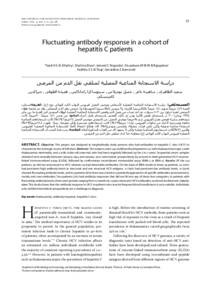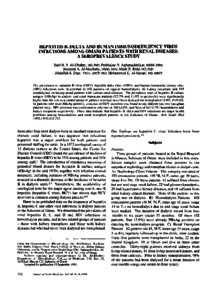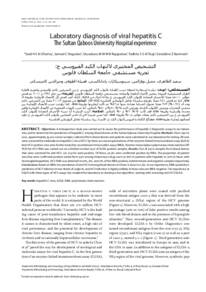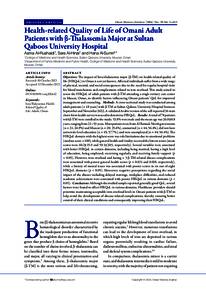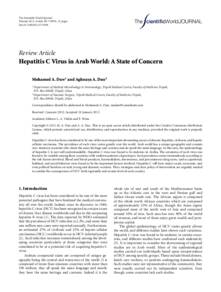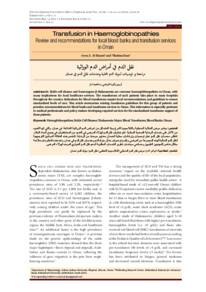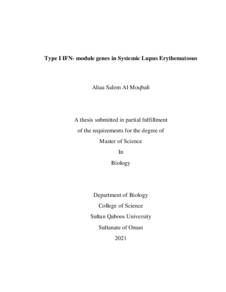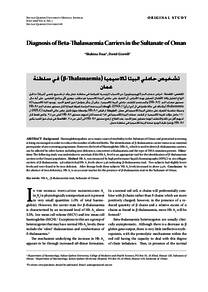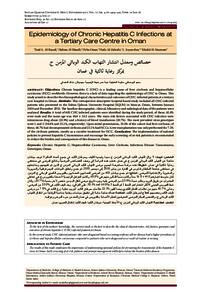Document
Fluctuating antibody response in a cohort of hepatitis C patients.
Contributors
Other titles
دراسة الاستجابة المناعية المصلية لمتلقي نقل الدم من المرضى
Publisher
College of Medicine, Sultan Qaboos University.
Gregorian
2002-04
Language
English
English abstract
Objective: This project was designed to longitudinally study persons who had antibodies to hepatitis C virus (HCV) to characterise the serologic course of infection. Methods: The subjects were 149 multitransfused patients (141 with thalassaemia major, 3 with thalassaemia intermedia, and 5 with sickle cell anaemia) who had been regularly followed up for 3 to 7 years. Sequential serum samples obtained semi-annually between January 1994 and January 2001 were tested, prospectively, by second or third generation HCV enzyme-linked immunosorbent assay (ELISA), followed by confirmatory recombinant immunoblot assay (RIBA-2 or RIBA-3). Results: Of the 149 patients, 90 did not seroconvert to HCV, whereas 59 had detectable antibodies. On the basis of RIBA results in these 59 patients, 24 (41%) had persistent high antibody levels to structural and non structural HCV antigens, 11 (19%) had persistent low antibody levels, 17 (29%) showed fluctuating antibody levels, and in 5 patients (8%) there was a total or a partial disappearance of specific antibodies (seroreversion), mainly anti-core antibodies. Two patients (3%) had antibody responses that did not fit into any of these four categories. In patients with fluctuating antibody levels, there were periods ranging from 6 months to 2 years when anti-HCV antibodies could not be detected. Conclusion: This study shows that the antibody response to HCV in patients who receive frequent blood transfusions is very variable. Individuals who exhibit intermittent seropositivity are a challenge to diagnosis.
Member of
Resource URL
Citation
Al-Dhahry, Said H. S., Daar, Shahina, Nograles, Jameel C., Rajapakse, Situsekara M. W. W. B., Al-Toqiyah, Fadhila S. S.,& Kaminski, Geraldine Z. (2002). Fluctuating antibody response in a cohort of hepatitis C patients. Sultan Qaboos University Medical Jo
Arabic abstract
المستخلص: دراسة الاستجابة المناعية المصلية لأشخاص موجبي المصل لفيروس التهاب الكبد الوبائي نوع (ج). الطريقة شملت العينة ١٤٩ مريضاً منهم ١٤١ مريضاً بالثالاسيميا الكبرى و ٣ مرضى بالثالاسيميا المتوسطة وع مرضى بفقر الدم المنجلي. وقد تم متابعة هؤلاء المرضى لفترة تتراوح بين ٣-٧ سنوات. تم أخذ عينات من مصل الدم وفحص الاستجابة المناعية المصلية لهؤلاء المرضى في الفترة ما بين يناير ۱۹۹۴ وینایر ۲۰۰۱م باستخدام فحص الاليزا ومن ثم تأكيد الفحص باستخدام طرق أخرى . النتائج من ضمن ١٤١ مريضاً، ٩٠ مريضاً كانت نتيجة هم سلبية لفحص مصل الفيروس ج ، و ٩٥ مريضاً موجبي المصل. من المرضى موجبي المصل ٢٤ مريضاً (٤٩) كانت استجابة هم المناعية مكثفة ومستمرة لأجزاء من مكونات الفيروس ول ۱۱ مريضاً (۱۹) كانت استجابة هم مستمرة ولكن ضعيفة، بينما ظهرت ۱۷ مریضا (۲۹) استجابة مناعية ضعيفة ولكن على فترات متفرقة ولخمس مرضى (۸) كان هنالك اختفاءا كاملا للاستجابة المناعية المصلية للفيروس. دراسة الاستجابة المناعية المصلية لمتلقي نقل الدم من المرضى.
Category
Journal articles

